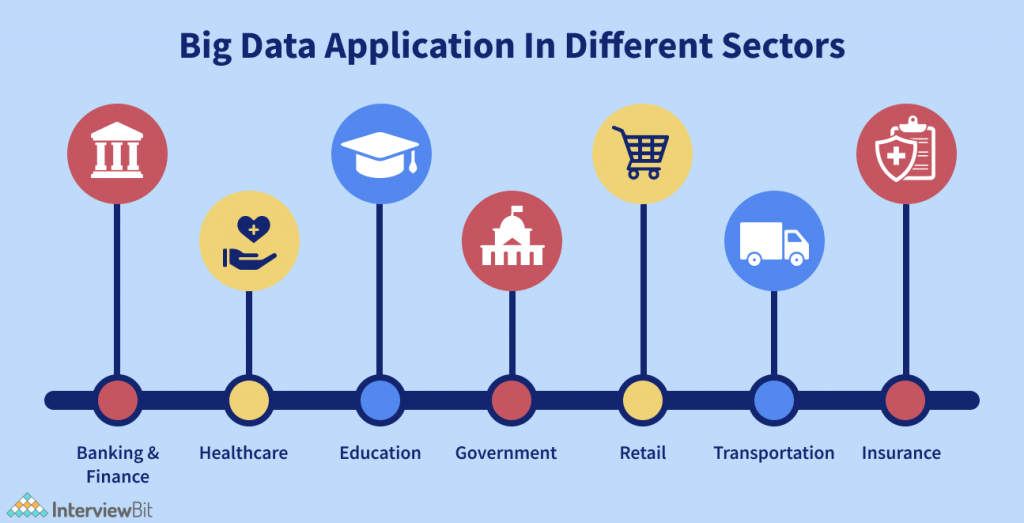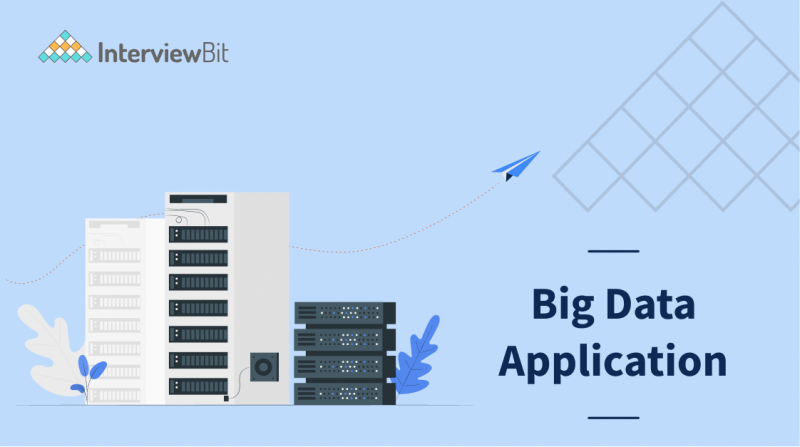- Introduction
- The Three V’s of Big Data
- The Value and Truth of Big Data
- Big Data challenges
- How Big Data Works
- Applications of Big Data
- 1. Banking
- 2. Education
- 3. Media
- 4. Healthcare
- 5. Agriculture
- 6. Travel
- 7. Manufacturing
- 8. Government
- 9. Retail
- Conclusion
- FAQs
- Q.1: Where is big data used?
- Q.2: What are the advantages of big data?
- Q.3: What are the characteristics of big data applications?
- Additional Resources
Introduction
Seven years back, the New York Times declared the advent of “big data.” Previously, it was considered as another buzzy concept and now it impacts how we live and work significantly. By the end of 2018, more than 90 per cent of businesses divulged to benefit from the increasing power of big data even as privacy advocates discredit its potential pitfalls.
Big data is described by the three Vs: volume, velocity, and variety. There are loads of it flowing in at great speeds from various sources. And its consequence is enormous, regardless of industry. Big data has deduced once-holistic notions, including “what consumers want,” more measurable. It has promoted inductive reasoning, a controversial data-first inversion of the scientific method. At many organizations, it has brought forth a “culture of analytics” where even non-tech employees have the privilege to input data and also have access to data-driven insights.
The Three V’s of Big Data
- Volume: The volume of data is of utmost importance. With big data, you will have to process huge amounts of unstructured data, low-density. It can be data of undefined value, including Twitter data feeds, clickstreams on a mobile app, clickstreams on a web page, time-series data, or sensor-enabled equipment. For some companies, it can be tens of terabytes of data. For other organizations, it can be hundreds of petabytes.
- Velocity: The rate at which data is collected and acted on is termed velocity. Generally, the highest velocity of data runs straight into memory as compared to being written to disk. Some internet-supported smart products perform in real-time or close to real-time and will need real-time assessment and action.
- Variety: Variety is considered as the various kinds of data that are available. Traditional data types were structured and neatly fit in a relational database. Data comes in new unstructured data types with the advance of big data. Unstructured and semi-structured data types, including video, text, and audio need extra preprocessing to determine meaning and support metadata which is the context around that data.
Here’s a complete guide on the Characteristics of Big Data.
Confused about your next job?
The Value and Truth of Big Data
Two more Vs have developed over the last years namely veracity and value. Data holds intrinsic value. But it is of no worth unless that value is determined. Another equally important question is how accurate is your data and how much can you trust it. Now, big data has turned to capital. Take some of the world’s biggest tech companies into consideration. A huge part of the worth they grant comes from their data, which they are regularly investigating to create more productivity and create new products.
The latest technological findings have considerably diminished the value of data storage and computing. Thus it makes it easier and less pricey to store more data than ever before. With an expanded volume of big data being more affordable and more accessible, one can prepare more detailed and accurate business decisions. Discovering the value in big data isn’t only about investigating it, it is a complete discovery process, which needs business users, insightful analysts, and executives whose job entails asking the right questions, recognizing patterns, making well-read assumptions, and predicting behaviour.
Real-world Big Data examples:
- Learning about consumer shopping habits
- Customized marketing
- Discovering new customer leads
- Fuel optimization devices for the industry of transportation
- Prediction of user demand for ridesharing businesses
- Observing health conditions via data from wearables
- Live road mapping for independent vehicles
- Streamlined media streaming
- Predictive inventory ordering
- Customized health plans for cancer patients
- Real-time monitoring of data and cybersecurity protocols
Almost every business utilizes big data for prospective planning by foretelling how consumers will live and what they’ll buy. However, it is not a crystal ball. Some kinds of data sets, like those that span decades, have better predictive power as compared to a similar amount of data from only a year. When it comes to predicting unexpected cultural shifts, like the surge of smartphones, even the most sterling data has its shortcomings.
Big Data challenges
Though big data guarantees a lot of hope, it has some shortcomings as well. Firstly, big data is huge, though the latest technologies have been procured for data storage, data volumes have doubled with every passing year. Businesses still strive to maintain pace with their data and uncover ways to efficiently store it. But that is not enough to just save the data. Data that are best suited to the client and systematic in nature, enabling insightful analysis, needs a lot of work. Data scientists spend 50 to 80 per cent of their time procuring and prepping data before it can be used. This step is called Data Preprocessing. Lastly, big data technology is growing at a fast pace. A few years back, Apache Hadoop was the most prevalent technology that used to work with big data. Later Apache Spark was launched in the year 2014. As of this day, the combination of Apache Hadoop and Apache Spark is considered to be the best approach. Nevertheless, keeping up with big data technology is a continuous challenge.
How Big Data Works
Big data offers you a new perspective that brings forth new possibilities and business models. Getting started includes three important actions:
1. Integrate
Big data accumulates data from multiple different sources and applications. Generally, traditional data handling and integration mechanisms, including extract, transform, and load (ETL) aren’t capable of the task. It needs the latest strategies and technologies to examine big data sets at terabyte, or even petabyte, scale. During the process of integration, you have to bring in the data, process it, and have to make sure the data is formatted and available in a form required by the business analysts.
2. Manage
Big data needs storage. You can store it in the cloud, on-premises, or both. Also, the data can be stored in any form you need and bring your coveted processing requirements and essential process engines to those data collections on an on-demand basis. Several people pick their storage solution as per where their data is residing currently. The popularity of the cloud is gradually increasing as it supports your computing needs and lets you spin up resources as deemed necessary. In cloud storage, you also can pay for the data storage as you go and do not need to purchase a lot of storage capacity upfront.
3. Analyze
The investment in big data meets expectations when you analyze and work on your data. You can get a new perspective with a visual analysis of your different data sets. Look deeply into the data further to make discoveries. Let others know about your findings. Develop data models with the help of artificial intelligence and machine learning. Make your data work.
Applications of Big Data

We have pointed out industry verticals in this article that have adopted Big Data, and how they have applied the technology, along with compelling examples.
1. Banking

Be it financial management or cash collection, big data has made banks more efficient for each industry. The technology’s application has defeated the user’s struggle, helping the bank to generate more revenue and their insights are more transparent and comprehensible than before. Varying from distinguishing fraud, analyzing and streamlining transaction processing, improving understanding of the users, perfecting trade execution, and promoting an exceptional user experience, Big Data extends a range of applications.
An interesting example of a company making use of Big Data efficiently in this sector is of Western Union. The company promotes an omnichannel approach that personalizes user experiences by processing more than 29 transactions per second and collecting all the data onto a common platform for the purpose of statistical modelling and predictive interpretation.
2. Education

When talking about the Education industry, the data garnered from the courses, students, faculty, and results is huge, the interpretation of which can bring forth insights useful for improving the operations and functioning of educational institutes. From promoting efficient learning, improving International recruiting for universities, supporting students in establishing career goals, decreasing university dropouts, promoting definite student evaluation, enhancing the decision-making process, and improving student results, Big Data has an indispensable role in this sector.
An outstanding example would be that of the University of Florida. The university uses IBM InfoSphere for obtaining, loading, and transporting data through various resources. The university employs IBM SPSS Modeler in the case of predictive analytics and data modelling, and IBM Cognos Analytics for examining and foretelling the performances of students.
Several variables varying from the student’s grades, demographics, and economic background aid in measuring the assess dropout possibilities for the students. This helps the university in establishing its policies and promoting regular intervention for students on the verge of dropping out.
3. Media

The buzz for the conventional methods of consuming media is gradually fading away because the current strategies of consuming online content with the help of gadgets have become the latest trend. Since an immense amount of data is generated, big data has triumphantly made its way into this industry. Ranging from assisting to predicting what the audience needs, in the genre, music, and content as per their age group, to proposing them insights regarding customer churn, Big Data has made the lives of media houses much easier.
Another appropriate example of how big data plays a pivotal role in transforming media platforms would be Netflix. The technology not only impacts the series invested in by Netflix but also how the series is presented to their users. The search history and viewing history of the user, including the places where the user has paused the video, impacts everything from the personalized thumbnails to the shows we watch on the “Popular on Netflix” section.
4. Healthcare

Big Data has an essential role to play in improving modern healthcare operations. Technology has fully remodelled the healthcare sector By decreasing the cost of treatment, predicting epidemic outbreaks, dodging preventable diseases, improving life quality, prophesying the income obtained by daily patients to adjust staffing, adopting Electronic Health Records (EHRs), using real-time alerts to promote immediate care, utilizing health data for more efficient strategic planning, to decreasing frauds and flaws.
Mayo Clinic is a credible example of Big Data in healthcare. The platform embraces big-data analytics to help in identifying various conditions of patients and enhancing their life quality. This analytics can also identify at-risk patients and grant them more comprehensive health control and necessary medical intervention.
5. Agriculture

In the field of Agriculture, big data analytics drives smart farming and accurate agriculture operations, saving costs and unleashing new business possibilities. Some important areas where big data work involve meeting the food demand by providing farmers with information regarding the changes in weather, rainfall, and factors affecting crop yield, propelling smart and correct application of pesticides, management of equipment, guaranteeing supply chain productivity, etc.
A Bayer Group unit, Bayer Digital Farming, uses machine learning and artificial intelligence to identify weeds. Farmers share pictures of weeds in the app and then match them against a large Bayer database to detect the species. This app intervenes at the appropriate time, shielding the crops and improving yields.
6. Travel

Big Data plays an intrinsic role in shaping transportation in a more perfect and effective manner. Be it managing the revenue earned, maintaining the reputation gained, or following strategic marketing, Big Data has influenced this sector. It also helps in mapping out the route as per the requirements of the user, assisting in efficiently managing wait time, and identifying accident-prone areas to increase the safety level of traffic.
The perfect example of Big Data’s use in the transportation industry would be Uber. The platform creates and uses a huge range of data on vehicles, drivers, locations, and the trip made by each vehicle, which is again tested and utilized for foretelling the demand, supply, accurate location of drivers, and trip fares.
7. Manufacturing

Thanks to Big Data, manufacturing is no longer an arduous manual process. Technology and Data analytics have succeeded in completely revolutionizing the manufacturing process. Big Data improves manufacturing, personalizing product design, guaranteeing accurate quality maintenance, overseeing the supply chain, and also evaluating to keep track of potential risks.
Rolls Royce is an interesting example of the importance of big data in this industry. The company uses Big data analytics for improving its design process, decrease its product development term, and magnify the production and quality of its products, at the same time reducing costs. The platform has also made its production processes easier by rectifying errors happening amidst the design process.
8. Government
Governments come across a huge level of data on an everyday basis, irrespective of the nation as they have to maintain various records and databases of their citizens, growth, geographical surveys, energy resources, etc. This data is needed to be reviewed and analyzed, thereby becoming an ally for the government in its operations. Primarily, the government utilizes this data in two areas, in its developmental plans and in the case of cybersecurity.
The Department of Homeland Security (DHS) is an important example of the government’s utilization of Big Data. For ensuring security, the Department of Homeland Security (DHS) uses an intrusion-identifying system for sensors that has the capacity to investigate internet traffic both in and out of Federal systems other than recognizing attempts of malware and unsanctioned access.
9. Retail

Talking about retail, big data plays an important part in foretelling rising trends, targeting fitting customers at the relevant time, reducing marketing expenses, and improving the quality of customer service. From keeping a detailed view of each user and promoting personal engagement, enhancing pricing to acquire the best value from forthcoming trends, systemizing back-office operations, and improving customer services, Big Data gives a wide array of applications when it comes to Retail.
Amazon uses the Big Data obtained from consumers to grow its recommendation engine. The more Amazon learns about its consumers, the better it can foretell what the consumer long to buy. Knowing about consumer behaviour enables them to simplify the process and convince the consumer to purchase it, like recommending particular products instead of making the consumer browse through the entire catalogue.
Conclusion
In a nutshell, Big Data is a real game-changer. It is worth every effort you put in familiarising yourself with Big Data analytics applications, the particular hurdles faced by the businesses, Big Data uses, and its data characteristics, and staying informed of market solutions. The implementation of Big Data is developing and one can gain expertise in a particular vertical to explore the best career opportunities in Big Data applications. Big data analysts are at the forefront of the journey towards a world, which is ever more data-centric.
FAQs
Q.1: Where is big data used?
Ans: Big data is the assortment of technologies designed to save, examine and handle this bulk data, a macro-tool devised to recognize patterns to design smart solutions to businesses, making their life easier. Now, it is applied in domains as different as agriculture, medicine, gambling and environmental protection.
Q.2: What are the advantages of big data?
Ans: When the company’s decisions rely on data and facts, it considerably enhances the pace of decision-making. With the help of real-time data, and former data patterns, the process of decision-making becomes quick, and secure as the company can devise confident decisions.
Q.3: What are the characteristics of big data applications?
Ans: The three basic aspects of big data include volume, velocity, and variety. Added features of big data are visualization, variability, veracity, and value. Knowing the features of Big Data is the answer to determining its usage and application properly.







 Join WhatsApp Group
Join WhatsApp Group


